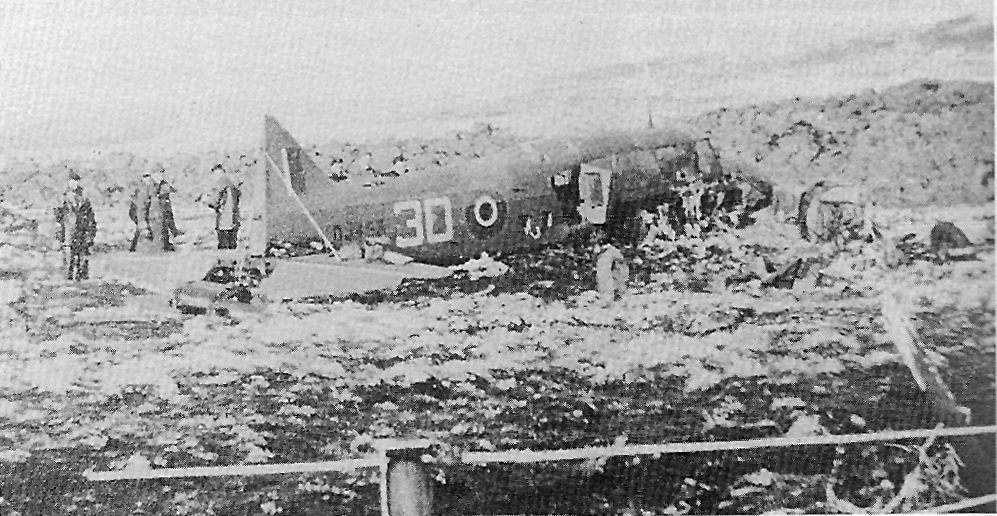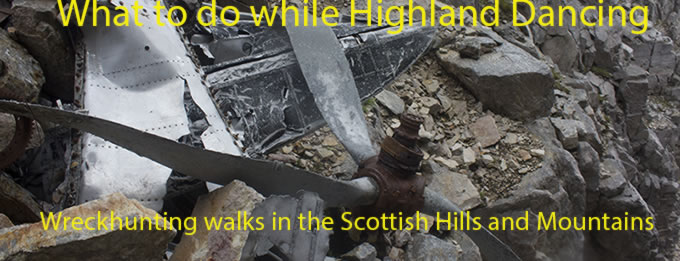A scenic stroll around the
northern Pennines-part 2
Avro Anson DJ453 and Supermarine Spitfire K9888.
(Distance
covered = 9.0 mile/Ascent =+647m)
On my first visit to Great Dunn Fell in 2016 I succeeded in finding 4 out of the 8 crashsites I went to look for. Now two weeks later an ideal opportunity arose to nip back and have another go at three of the four I failed to find or more accurately in the case of two of them, failed to reach.
Heather's competition on this weekend was at Locharbriggs, beside Dumfries. They had been arranging a lift over to this one recently but today they only had a lift back, so I had to take them. This was ideal as I could drop them off at the competition then nip along to Great Dunn Fell again, as it was sort of on the way home.
Parked up at exactly the same spot as two weeks earlier.
Driving up the access road to Great Dunn Fell I caught up with two cyclists who were busting a gut peddling up a particular steep section; I was going to bide my time until they made it to the top but they pulled over to let me past, which I did. As I passed the second one I heard the first one swear very loudly as he fell off his bike, not because I had hit him but because he'd forgotten that he was unable to put his feet down because they were fixed to the pedals.
Off along the Pennine Way, the Meteor and Wellington crashsites I visited on my previous expedition up here are over the other side of the hills in the distance.*
As I now knew exactly where the Spitfire wreckage wasn't located and had a good idea where it was I decided to head over to Cross Fell first to look for an Anson and a DH60 that crashed up there, just in case the weather deteriorated later on. I knew both sites were amongst boulders so it would be much easier searching while it was dry and sunny.
Approaching the NATS Radar Station on Great Dunn Fell.
above and below:-I also took these two photos on my earlier visit* but today the visibility was a bit better and they were at the start of my walk and not at the end, as I was going anticlockwise this time!
The Radar Station
Little Dunn Fell with Cross Fell beyond, the location of the Anson crashsite is marked with a yellow cross.(just
on this photo, there isn't actually a giant yellow cross painted on the
Hillside#sister)
In the saddle between Great Dunn Fell and
Little Dunn Fell. If I was in Scotland this would have been a baelach but
as it's in Cumbria it's called a saddle.
Two more photos I also took two weeks earlier, again with a bit better visibility.
View across to the Anson crashsite from
Little Dunn Fell.
Cross Fell from Little Dunn Fell. The DH60 crashed at the base of the steep section just left of centre
albeit a little further west around the side of the hill.
I made very good time thanks to the nicely laid paving stones on the Peninne Way, so by the time I reached Cross Fell I was confident I was going to have time to go and look for a Jaguar crashsite on Black Fell after I'd finished up here. Black Fell was also on the way home.
Almost at Cross Fell summit, this is roughly the point where I joined the Peninne Way on my way back to the car last time after visiting the Lockheed Hudson crash lower down the hillside at Wildboar Scar.
In the saddle between Little Dunn Fell and Cross Fell looking back to Little Dunn Fell.
Just before reaching the summit plateua of Cross Fell I had to leave the pavement and go off piste to the east towards a boulder field where the Anson wreckage was located. It was easy to locate today as I could see it from miles away.
The Peninne Way pavement snaking its way over Little Dunn Fell and Great Dunn Fell
The crashsite is below the summit plateau, the remaining wreckage lies at the
edge of a boulder field and is marked with a giant yellow arrow which the
wind had blown over but I stood it up again!
A small pile of Anson wreckage collected together amongst the boulders.
The Anson was relatively intact when in crashed, it slid on its belly up a grassy area of the hillside before coming to rest with its nose on the boulders where the remaining wreckage can be found.
Above and below:-The Anson flew towards the camera then hit the hillside and slid along the grass on its belly before coming to rest with its nose on the boulders in the foreground.

No83 Maintenance Unit at the Crashsite of Anson DJ453
in 1943. The fence in the foreground can be seen in the background of the
photos above which were taken looking in the opposite direction.
A comparison photo I took on another visit in July of 2024,
I stood at this spot for over half an hour waiting for the visibilty to
improve enough to be able to see the rocks in the background.
above and below:-Some fragments of Anson amongst the boulders.
The location of the wreckage at the southern edge of the boulders.
From the Anson crashsite I had a short haul up onto the summit plateau of Cross Fell with a few large areas of light green stuff to avoid on the way. Once up onto the top the weather took a decided turn for the worst with the wind picking up and some ominous dark clouds replacing the white clouds and blue sky..
This patch of green quicksand necessitated a large detour.
View of the Anson crashsite from near the top of Cross Fell.
Above and below:-On top of Cross Fell; If Carlsberg made cairns!
I wasn't expecting to find anything at the second crashsite of the day, a DH60 Moth that crashed on a steep and nasty boulder field just below the summit of Cross Fell. I don't believe many if any people have managed to find any remains of this DH60. If as reported there's only small pieces left and because of the nature of the rocks it would be a case of sheer good luck to look behind or under the correct boulder amongst the thousands that cover the slope. (In July of 2024 I eventually found remains of this DH60**)
above and below:-The area where the DH60 crashed, there's probably some pieces somewhere amongst all those rocks.
I managed to get clear of the boulder fields and back onto the Peninne Way pavement before the congregating clouds unleashed their full fury on me. The weather which started off quite pleasant and sunny quickly became worse than on my previous visit; much worse. After battling my way back over Little Dunn Fell, which involved being battered from large lumps of horizontal rain which were being driven by a very strong wind from the west; I eventually arrived back in the saddle between Little Dunn Fell and Great Dunn Fell. From here I had two choices, play it safe and follow the pavement back to the car or leave the path and follow a compass bearing into the gloom towards the abandoned mine, just past which lay the crashsite of the Spitfire that I missed last time.
At least the old mine building offered some shelter from the now attrocious weather
but because of the wind there was a lot of spooky noises eminating from
other parts of the building.
No 5137 on my 'nice place to have a picnic' list. But at least I was able to eat my sandwiches without them becoming soggy!
It looked even creepier in the mist and gloom!
Considering I'd failed to find any remains of Spitfire K9888 last time when the weather was behaving and the visibility was good, such is the way of life that today, when I could barely see 10 feet in every direction and with the torrential rain doing its best to complicate preceedings, I found the remains of K9888 straight away.
Two large springs, although purely
conjecture, these look like they could have been part of the breech of the
browning maching guns.
Above and below:-Most of the fragments have been collected together and a large flat rock placed over them, which did a good job of concealing the pieces and probably contributed to me failing to find them on my first visit.
A piece of perspex lying very slightly higher up the hill.
A view of the area where the Spitfire crashed,
trying to get a photo before the lens became covered in rain proved
impossible!
Before I left I replaced the large flat stone and added a couple more to make a small cairn
to mark the spot. The white stick was lying amongst the pieces of
Spitfire, more usualy used by Gamekeepers to mark the location of their
Grouse feed boxes this one now marks the location of Spitfire K9888's
remains.
All that remained now was a mile or so trudge back to the Pug, this
involved a slog up the steep section of the access road that the two
cyclists were struggling up earlier, it seemed a lot steeper now I was
walking up it.
I would have had time to call by Black Fell on the way home to look for
the Jaguar crashsite up there, but as the weather was now doing a good
impersonation of a monsoon I opted to leave that one for another day.
Click these links for more
information about the crashes
yorkshire-aircraft.co.uk/dj453
